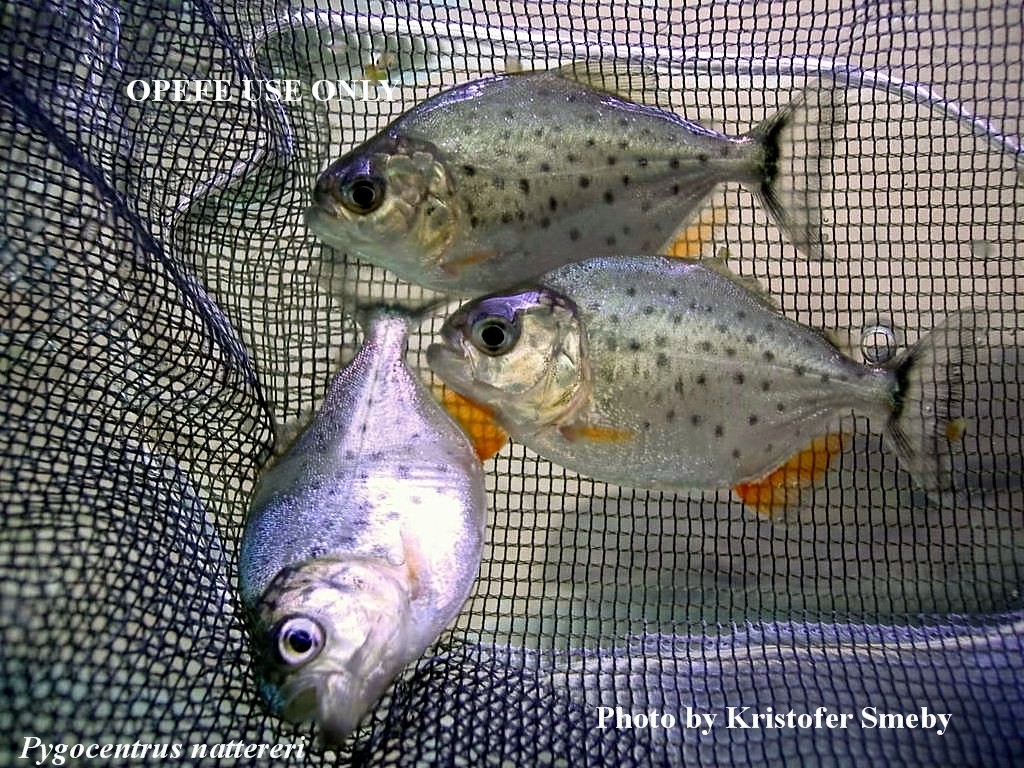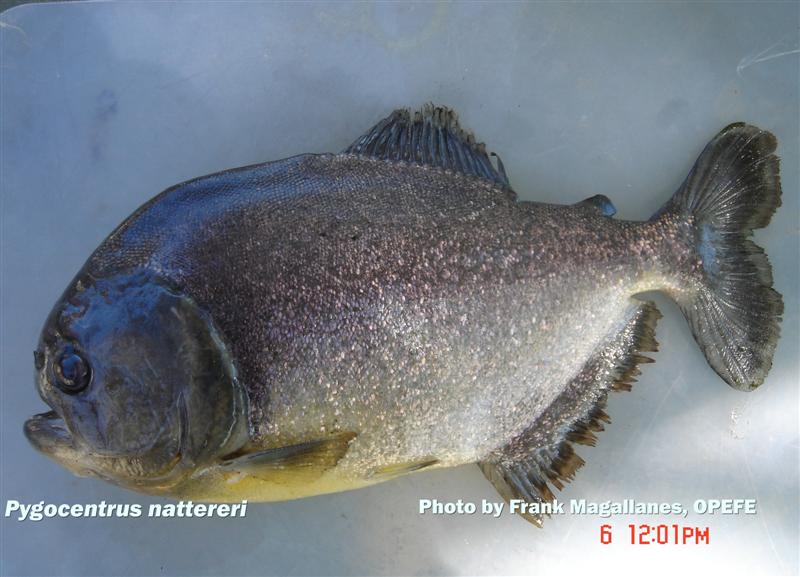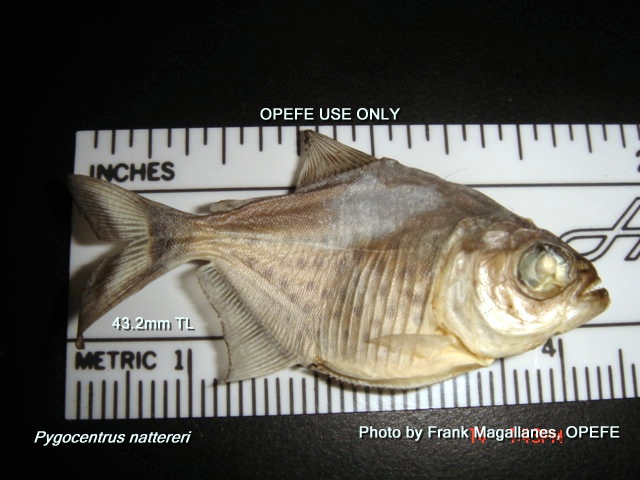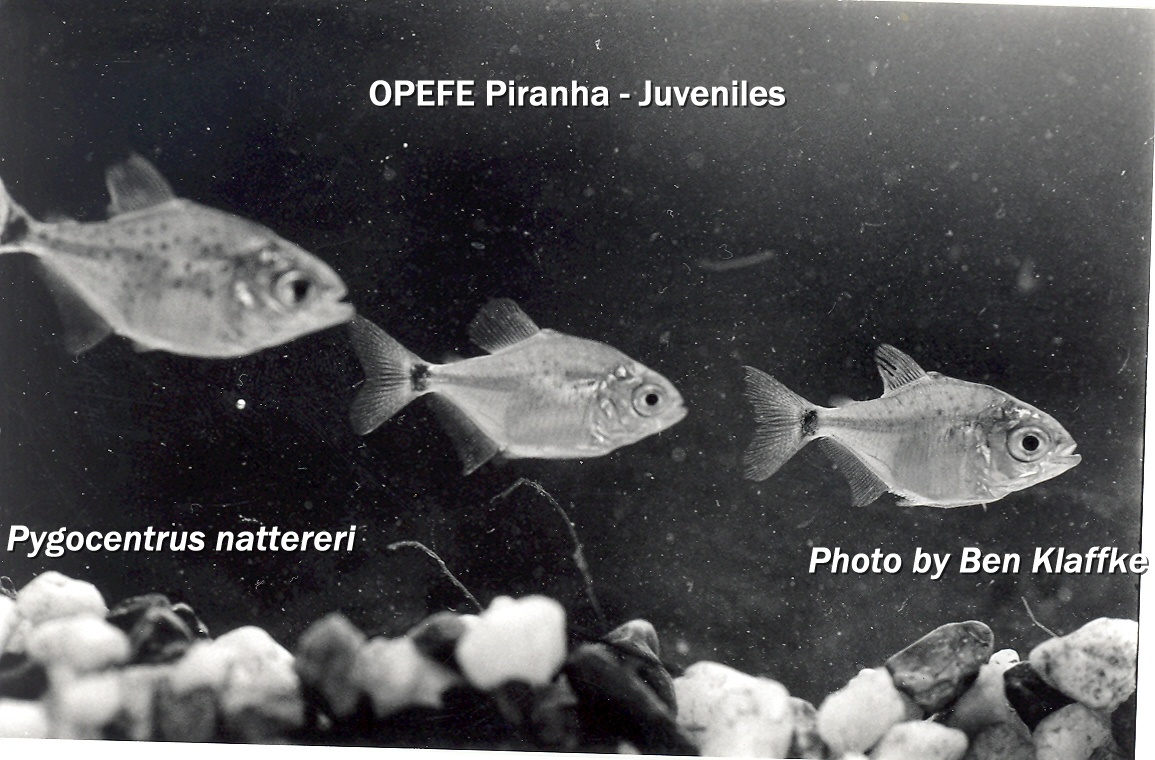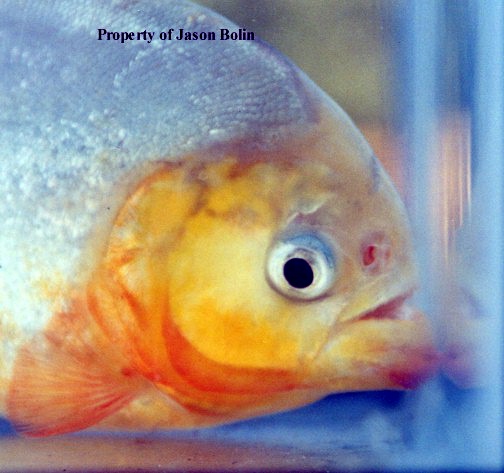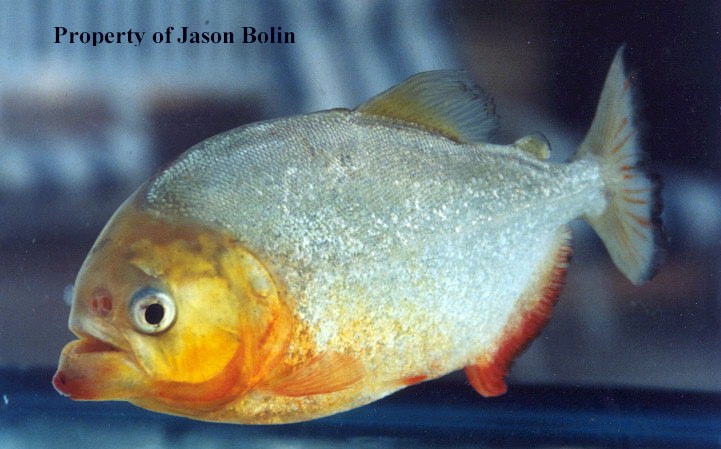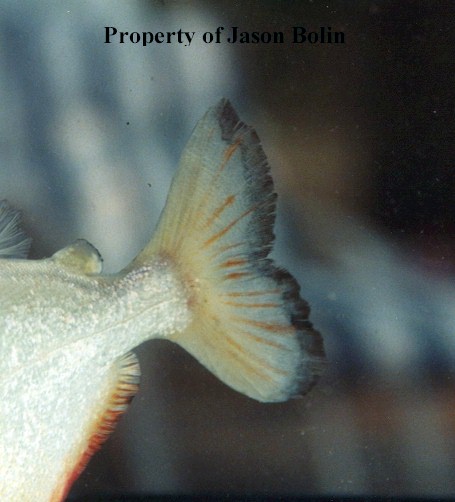TRUE PIRANHA
Common name: Red Piranha, Natterer's piranha, red-belly, ternetzi, super red, snakeskin
Pygocentrus nattereri
KNER, 1860
CURRENT STATUS: Valid
From Frank Magallanes
This species was one of the first piranha I ever owned in 1964, where it was purchased at a pet store as a juvenile. It was also the one and only piranha to bite me by accident in 40 years of keeping these species. These first specimens of piranha were also used in my own home test on cold tolerance (VIEW). Subsequently, many more were added to my growing collection over the years. During 1980, I had 2 successful spawning of the species. Pygocentrus nattereri is a complex species with many variations of spotting, body shape and coloration. Much of the morphology is dependent on water chemistry and food. Another problem that comes into the mix is that P. nattereri is readily bred in home aquariums. So the coloration or body shapes appear dissimilar to wild caught VIEW P. nattereri. Because of these changes that occur, hobbyists are sometimes confused by the differences seen with wild caught vs. tank raised. That is understandable. Wild caught colors are more brilliant in their native waters, but once put into the environment of the home aquarium, the stress and lack of natural foods takes a toll on the fishes appearance. And that is where the confusion begins when a hobbyist sees a red-belly piranha that may have a different head shape or dull colors. Much argument over size of jaw is similar to arguments once brought forth by old science, but now we know that such traits are individualistic and should only be considered as a small fraction of how to identify a species.
Please take you time and read through this entire web page including its links. It will help you get a better understanding how complex these species are.
Recorded examples range from 30-35 cm total length. Aquarium specimens are usually smaller. Being the most common piranha found for sale in U.S. pet industry, these fish has provoked fear in conservationists and the media (see genus Pygocentrus VIEW). The fish are found in a variety of belly colors ranging from yellow-orange-red. Body colors are also as variable being; silver-gold-black. Some are so intensely gold-speckled that they are also commonly called "gold-dust piranha". The head shape of these piranhas also appear to be variable, some being very blunt-headed and having little to no concavity above the profile of the eyes. This has been attributed to the type of diet the fish is restricted to. This species is relatively small, with a 3- pound 7-ounce specimen holding the world angling record, River Cuiaba, Mato Grosso, Brazil. (Source: Field and Stream 2002). Some imported Pygocentrus type piranhas have been reported to lack the presence of the adipose fin or the adipose fin is reduced in size. Researchers are reminded that without the naturalness (synapomorphy) of the adipose fin the fish would not be a member of the subfamily Serrasalminae. Piranhas do bite each other and the loss of an adipose fin can be attributed to that. As for reduction in size, that depends on environmental factors and diet, after all the adipose fin is fatty tissue and not unreasonable to assume that an emaciated fish lives on its fat storage when faced with periods of drought. The area above the eyes (dorsum) is also seen in some wild caught specimens and the occasional pet trade piranha to appear very emaciated (skinny and drawn). This piranha must be encouraged to eat fish and other matter, since the dorsum area is a fat and muscle storage area. Hobbyists also look at body length to assume this character prescribes a different feature, Fink in his revision did a body comparison of all P. nattereri within its range and found nothing to suggest that elongation of the body is a specific feature in one locality. Indeed elongation is more an individualistic trait within populations of P. nattereri throughout its range. Some species like Pygopristis denticulata require the feeding of seeds VIEW (Magallanes, 1993) in order for the fish to replace this fatty tissue.
LONGEVITY IN CAPTIVITY
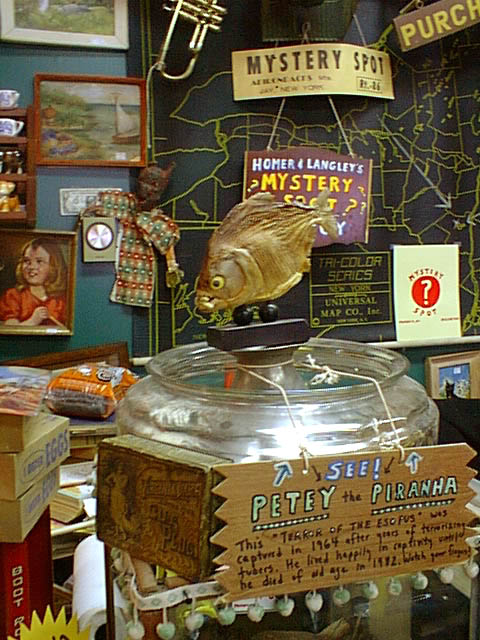 In nature, piranhas are eaten by other animals and of course
cannibalized by their own relatives, so many do not live long. In the aquarium,
that is another matter. Reported ages in captivity run from a few days and in a
few are cases over 20 years. However, 10 years seems to be the norm via aquarist
care. For those that enjoy keeping piranhas as pets, they can live for
quite some time. Meet Petey the Piranha. *This "Terror of the Esopus"
was captured in 1964 after years of terrorizing tubers. He lived happily in
captivity until he died of old age in 1982. Watch your fingers! * Petey is a gag.
In nature, piranhas are eaten by other animals and of course
cannibalized by their own relatives, so many do not live long. In the aquarium,
that is another matter. Reported ages in captivity run from a few days and in a
few are cases over 20 years. However, 10 years seems to be the norm via aquarist
care. For those that enjoy keeping piranhas as pets, they can live for
quite some time. Meet Petey the Piranha. *This "Terror of the Esopus"
was captured in 1964 after years of terrorizing tubers. He lived happily in
captivity until he died of old age in 1982. Watch your fingers! * Petey is a gag.
DEATHS ATTRIBUTED TO PIRANHAS
Scavenging on human corpses as a source for stories about man-eating piranhas Ivan Sazima and Sérgio de Andrade and Guimarães. Synopsis Piranhas have a reputation for man-eating, notwithstanding the absence of authenticated records of persons attacked and killed by these fishes. Three cases of piranhas scavenging on human corpses were recorded in Mato Grosso, western Brazil. One corpse, found four days after drowning, was almost reduced to a skeleton. Another corpse was recovered in a few hours, also after drowning, without the soft parts of the head. The third corpse, recovered 20 hours after the victim fell into the water due to a myocardial infarction, had flesh only on the trunk. Pygocentrus nattereri and, to a minor extent, Serrasalmus spilopleura were probably the necrophagous piranhas. Some of the human deaths attributed to piranhas most probably are cases of scavenging on drowned or otherwise already dead persons, by these opportunistic schooling carnivores.
ALBINISMS and BREEDING
A hobbyist several years ago purchased a purported albino piranha. This fish while interesting does not appear to have the recessive gene that creates albinism in species. Nor does it exhibit the pink eye associated with such albinism. It could be called a "golden piranha" based on its color alone. The fish is likely a geographic variation, however, sometimes parasites can cause similar problems, but the fish looks in good health. (SEE PHOTOS BELOW)
P. nattereri (ternetzi) being bred in captivity
Tank raised - P. nattereri also commonly known as Ternetzi. Photos courtesy of Jason Bolin
The fish has plenty of red pigments mixed in with the yellow. This could later become redder if the fish becomes ready to reproduce. It was raised in dim light which would help explain part of the reason it lacks the intense coloration of the body. The fish was originally purchased from a piranha breeder in Ohio who has been producing this color (belly) variety for a number of years. The juvenile fish was then sold to another person (who kept the fish in dim light) which eventually made its way to the Pira-News2000 reader. The original fish breeder and I are old friends and I was fortunate to receive a few of these fish as gifts for OPEFE. Fink was also provided some samples and he was surprised the fish maintained its bright yellow belly color after being bred for so many years in the aquarium. Albino piranhas may or may not exist in nature. In my 50 years of examining piranha I have never seen one. Nor has Dr. William L. Fink, though he did intimate the possibility of its existence in nature. As discussed below, such critters are normally eaten by the clan as inferior. Piranhas raised in little to no light suffer from nutritional losses the sun (or artificial light) provides. The chromatophores (stellate cells) which produce color require certain vitamins which natural sunlight provides. This pigment and refractive granules are important and if they do not get light then certain things can happen to the pituitary gland which controls the hormone (called intermedin).
COLOR OF LIFE BY POPULATION: Read about P. nattereri and its geographical variations (ie; Super Reds, Ternetzi, etc): VIEW
-
Pygocentrus nattereri, from the Mato Grosso region of Brazil, the type collected from both the Amazon and Rio Paraguay systems, described by Kner (1860) as Pygocentrus. Considered the earliest available name for the undiagnosed species composed of Pygocentrus populations residing in those areas (William L. Fink, 1993).
-
Pygocentrus altus: Described from the Upper Amazon by Gill (1870) as a Pygocentrus. Sometimes considered valid, more usually synonymous with nattereri. Recently Géry et al. (1987) suggested that this name should be used for the common Amazonian Pygocentrus and that nattereri should be used for the southern populations of the genus. Their suggestion is not accepted here, because samples larger than they examined show the characters used do not discriminate the populations (William L. Fink, 1993). Gill, T. N. 1870, On some new species of fishes obtained by Prof. Orton from the Maranon, or Upper Amazon, and Napo Rivers. Proc. Acad. Nat. Sci. Phila. v. 22: 92-96. Distribution: Río Marañon or Río Napo, Amazon system, Peru or Ecuador.
-
Pygocentrus ternetzi: I have included a link for systemic information pertaining to Serrasalmo ternetzi (Steindachner 1908). Rio Paraguay at Descalvados, Mato Grosso, Brazil. Holotype (unique):
COMMENTS; [About commonly called super reds or snakeskin Pygocentrus nattereri:]
The common name Super Red is meaningless for any specific P. nattereri since these fish can be highly colored in dark red or reddish-orange within its range. The common name has been applied to fish from Peru. A look at the geographical forms of P. nattereri VIEW) can show that some are more brilliant than others. This color can also be lost during the fishes growth in your aquarium or a dealer's tank as the fish matures. The dealer who coined that name for his fish was probably unaware (at the time) this name could apply to a number of species. It is a relatively new name in the piranha hobby and it is indeed foolish to just attach it to just one locality of P. nattereri. As for the reticulated P. nattereri, this feature is found on some but not all of the fishes from the middle Amazon. If one wanted to call this a Snakeskin, then that would be fine for a common name so long as the person understands that feature is eventually lost behind the brilliant scales. For some unknown reason, this name was eventually grouped with Super Red. Again its value is a minor concern. The real value in these wild fishes is the fact they are wild and can replenish a diminished gene pool if you are into breeding piranhas. Some people collect solely for their beauty (which is what I do). Others because they are "wild" and in that there is value.
The important thing for everyone to remember is be informed and don't blame dealers if they use a common name. It's up to you the consumer to know the difference.
ABSTRACT
Alimentação e ecomorfologia de duas espécies de piranhas (Characiformes: Characidae) do lago de Viana, estado do Maranhão, Brasil (Feeding and ecomorphology of two species of piranhas (Characiformes: Characidae) from the Viana Lake, Maranhão state, Brazil). PIORSKI Nivaldo Magalhaes ; ALVES José De Ribamar Lima ; MACHADO Monica Rejany Barros ; CORREIA Maria Marlucia Ferreira:
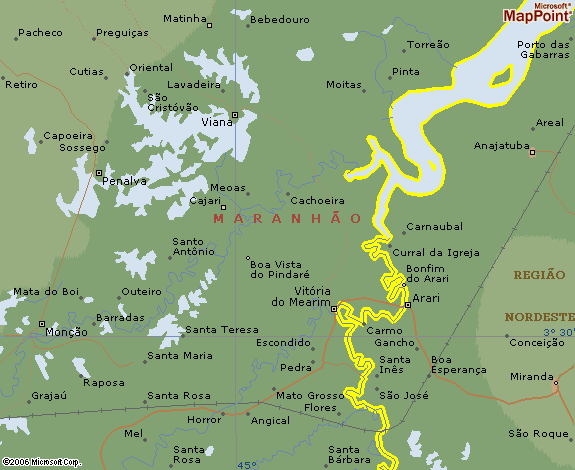 *Serrasalmus aff. brandtii and Pygocentrus
nattereri are two species of piranhas, both common in the Viana Lake, which
is formed by the flooding waters of the Pindaré River, a tributary of the left
bank of the Mearim River. A sample composed of 249 specimens of these species
was studied in order to identify diet composition and feeding strategies
employed by the two species. The piranhas were captured tri-monthly, during one
year from March 1999 using gill and fishing nets of different mesh sizes. The
qualitative composition of the diet was analyzed through the frequency of
occurrence method. The feeding strategies employed by the piranhas were inferred
using the graphic method of Costello (1990), modified by Amundsen et al. (1996).
The results indicated that fish was the main food item in the stomach contents
of the two species, followed by plant material, more in the P. nattereri.
Fish and plant material showed different relationships in relation to piranhas
length classes. The graphic analysis of the feeding strategies employed by P
nattereri and *S. aff. brandtii suggest a generalist habit, wide
width niche with strong participation of the within-phenotype component, which
indicated that the majority of individuals of these species use several
resources simultaneously. A multivariate analysis of the ecomorphological index
indicated that the species are discriminated by swimming ability, water column
position and relative prey size. [*This species may well be a
misidentification. Readers are cautioned against assuming this species
identification is correct.]
*Serrasalmus aff. brandtii and Pygocentrus
nattereri are two species of piranhas, both common in the Viana Lake, which
is formed by the flooding waters of the Pindaré River, a tributary of the left
bank of the Mearim River. A sample composed of 249 specimens of these species
was studied in order to identify diet composition and feeding strategies
employed by the two species. The piranhas were captured tri-monthly, during one
year from March 1999 using gill and fishing nets of different mesh sizes. The
qualitative composition of the diet was analyzed through the frequency of
occurrence method. The feeding strategies employed by the piranhas were inferred
using the graphic method of Costello (1990), modified by Amundsen et al. (1996).
The results indicated that fish was the main food item in the stomach contents
of the two species, followed by plant material, more in the P. nattereri.
Fish and plant material showed different relationships in relation to piranhas
length classes. The graphic analysis of the feeding strategies employed by P
nattereri and *S. aff. brandtii suggest a generalist habit, wide
width niche with strong participation of the within-phenotype component, which
indicated that the majority of individuals of these species use several
resources simultaneously. A multivariate analysis of the ecomorphological index
indicated that the species are discriminated by swimming ability, water column
position and relative prey size. [*This species may well be a
misidentification. Readers are cautioned against assuming this species
identification is correct.]
IN THE AQUARIUM: Potentially Dangerous To Humans
Probably the easiest of the genus Pygocentrus to keep as large groups. It is also the most widespread species found in small groups of 25 up to several hundred during feeding frenzies. Some hobbyist's mix this species with the 2 members of genus Pygocentrus (piraya and cariba). While putting them together is unnatural (not found together in the wild), there is some success in accomplishing this. However, I prefer to err in caution and suggest only advanced hobbyist's attempt this under constant supervision. All 3 species of Pygocentrus are predaceous on each other and your aquarium as a closed system can make conditions such that might feed on each other. It is my suggestion that a single P. nattereri may be kept in a 40 U.S. gallon aquarium. Multiple specimens will require larger aquariums. Tank-raised P. nattereri appear to do better as small groups than their wild relatives. Though caution is required when introducing multiple groups because they are cannibalistic. They establish a pecking order with the larger specimens being more dominant and aggressive. This is when the opportunity is greatest that smaller specimens might be damaged or eaten by the larger specimens. Water temperature for in the aquarium can be between 74-82F. Higher temperature can make the species become more aggressive and also cause more stress. The species does it plants and I have recorded the seed eating behavior of the species in the home aquarium.
FEEDING
Foraging methods vary in different life stages of P. nattereri. During the day, smaller fish (80-110 mm) search for food. At dawn, late afternoon, and early evening the larger fish (150-240 mm) search for food. P. nattereri groups gather in vegetation in order to wait for prey. The group typically includes around 20-30 fishes. In the daytime P. nattereri can be seen lurking or ambushing prey. Two other methods for obtaining food employed by P. nattereri are chasing and scavenging. The hunting mode of chasing was seen after the fish lie and wait in vegetation. The fish then proceed to swim after and eat the fish. P. nattereri has a wide variety of food in its diet, including fins, scales, fish (pieces and whole), insects, snails, and plants. The plant intake of the animal may be an active way of gaining food supplies while scanning for prey (Sazima and Machado 1990). Fin nipping is a common type of feeding among the juvenile and young adult piranhas. They switch to whole fish when they are larger. The piranha's prey preference has yet to be determined, but evidence is pointing towards the perciform fishes, of the family Cichlidae (Kelso-Winemiller et al. 1993). Since fins are easily accessible and obviously a replenish able resource, fin-nipping is a very advantageous mechanism of feeding for the piranha.
TEETH
The teeth of Pygocentrus nattereri are broad, serrated, tricuspid and razor sharp. These teeth are used for slicing chunks of fish. The teeth are backed up by strong musculature that have enough force with combination of the razor sharp teeth to clip off a finger or toe! A medium sized P. nattereri (6 inch specimen TL) may have teeth as long as 4 mm. For larger specimens, the teeth may exceed that size in length.
SEXING AND REPRODUCTION/BREEDING
The species is not sexually dimorphic. Breeders of piranhas in the home aquarium note visual differences between the sexes, but this scrutiny is limited to fish that are observed for a period of time, up to and including pre-spawning activity. Then some differences can be noted, but subtle due to such activity. References to body girth or coloration is limited to the female being full of roe and the male in pre-spawning colors. Other references to thickness of first ray of anal or body girth is inconsequential to visually attempt to determine sex when the fish are observed in the wild and in a large group. Therefore it is of no value in determining sexual morphs of the species. I have placed a few links to access breeding information being accomplished by hobbyists below. P. nattereri seems to have a type of courtship display that involves swimming in circles. This results in ventral-to-ventral interactions among the male and female. Eggs are placed in the sediment, in bowl shaped nests. These nests are around 4-5 cm in depth and 15 cm in diameter. The eggs are in clusters and are attached to the bottom vegetation. There may also be a relationship between the times of the spawning and the time of the wet season. (Uetanabaro et al. 1993). The eggs of the piranhas are expelled during spawning and fertilized in the surrounding water. The adult males and females join in partial fertilization. The females are most fertile in the months of April and May. Their breeding habitat tends to be in main bodies of water, such as lagoons (Galvis et al. 1989). A rather large macrophyte population must be present for the young when they are born, so they can feed.
According to OPEFE water chemistry (VIEW), natural water and chemistry would be as follows:
WATER: pH 6.5-7.5 (7.0), 4-14 dH (8). Although in nature, the Paraguay piranhas can sometimes tolerate water temperatures as low as 59°F (15°C), it should be kept in water with a temperature from 70-77°F (21-25°C).
BREEDING ARTICLES
-
MAINTAINING PIRANHAS - by Marcus F. Tessem, Original Publication: Freshwater and Marine Aquarium Magazine October, 1992.
-
BREEDING THE RED-BELLIED PIRANHA - H. R. Axelrod (reprinted) From the "breeding aquarium fishes Book 4, 1976 TFH Publications, Inc.
-
BREEDING Pygocentrus nattereri - - - John shows you how.
MAXIMUM RECORDED SIZE
33.3 cm SL ( = 13.1 inches SL) or approximately 14 inches TL.
DISTRIBUTION
Amazon river. basin, Paraguay-Paraná river basin, NE. Brazilian coastal rivers and Essequibo river. basin: Argentina, BolIvia, Brazil, *Colombia?, Ecuador, Guyana, Paraguay, Peru and Uruguay. *The locality is in doubt since the only species reported there is Pygocentrus palometa, a nomen dubium.
Contributors and Advisors
-
Jégu, Michel
-
Fink, William L
-
Miriam Zelditch
-
Bolin, Jason
REFERENCES
-
Kner, R. 1858, Zur Familie der Characinen. Sitzungsber. Akad. Wiss. Wien 163-168.
-
Kner, R. 1860, Abstract of Kner 1860.
-
Gill, T. N. 1870 On some new species of fishes obtained by Prof. Orton from the Maranon, or Upper Amazon, and Napo Rivers. Proc. Acad. Nat. Sci. Phila. v. 22: 92-96.
-
Steindachner, F. 1908 Über sechs neue Serrasalmo- und Myletes-Arten aus Südamerika. Anz. Akad. Wiss. Wien v. 45 (no. 18): 359-367
-
Galvis,G., Mojica, J.I., Rodriguez, F. 1989. Estudio Ecologico de una Laguna de Desborde del Rio Metica. Universidad Nacional de Colombia. Fondo FEN Columbia. pp.60-62.
-
Sazima, I. and S. Guimaraes. 1987. Scavenging on human corpses as a source for stories about man-eating piranhas. En. Biol. Fishes 20: 75-77.
-
Reis, R. E., S. O. Kullander and C. J. Ferraris, Jr. 2003 Check list of the freshwater fishes of South and Central America. Check list Freshw. Fishes South & Cent. Amer. 2003: i-xi + 1-729.
-
Sazima, Ivan and Francisco Machado. 1990. Underwater Observations of Piranhas in Western Brazil. Environmental Biology of Fishes 28:17-31.
-
Vari, R. P. and J. C. Howe 1991 Catalog of type specimens of Recent fishes in the National Museum of Natural History, Smithsonian Institution. 1. Characiformes (Teleostei, Ostariophysi). Smithson. Contrib. Zool. No. 517: 1-5
-
Fink, W. L., 1993 Revision of Piranha Genus Pygocentrus (Teleostei, Characiformes), Copeia, 1993(3),pp.665-687.
-
Uetanabaro, Massao, Tobias Wang and Augusto Abe. 1993. Breeding Behaviour of the Red-Bellied Piranha, Pygocentrus nattereri, in nature. Environmental Biology of Fishes 38 :369-371.
-
Kelso-Winemiller,L.C., Winemiller, K.O. 1993. Fin-nipping Piranhas. National Geographic Research & Exploration. 9(3), pp.344-357
-
Fink, WL; Zelditch, ML (1995): Phylogenetic analysis of ontogenetic shape transformations: a reassessment of the piranha genus Pygocentrus (Teleostei). Syst. Biol. 44 (3), 343-360.
-
Zelditch, ML; Fink, WL (1995): Allometry and developmental integration of body growth in a piranha, Pygocentrus nattereri (Teleostei: Ostariophysi). J. Morph. 223 (3), 341-355.
-
Fink, WL; Zelditch, ML (1996): Historical patterns of developmental integration in piranhas. Amer. Zool. 36, 61-69
-
Gómez, S. E. and J. C. Chebez (1996) Peces de la provincia de Misiones. Chapter 4 in J. C. Chebez: Fauna Misionera. Catálogo sistemático y zoogeográfico de los vertebrados de la Provincia de Misiones (Argentina). L.O.L.A., Buenos Aires. Peces Misiones: 38-70 + Addenda 315-316.
-
Fink, WL; Zelditch, ML (1997): Shape analysis and taxonomic status of Pygocentrus piranhas (Ostariophysi, Characiformes) from the Paraguay and Paraná river basins of South America. Copeia 1997 (1), 179-182.
-
Machado-Allison, Antonio and Fink, William. - (1996) Los Peces Caribes de Venezuela, Diagnosis, Claves, Aspectos Ecologicos Y Evolutivos.
-
Fuller, P. L., L. G. Nico and J. D. Williams. 1999. Nonindigenous Fishes Introduced into Inland Waters of the United States. American Fisheries Society, Bethesda, Maryland.
-
Britski, H. A., K. Z. de Sz. de Silimon and B. S. Lopes 1999 Peixes do Pantanal. Manual de identificaçao. Embrapa. Serviçao de Produçal -SPI, Brasía, DF. Peixes Pantanal: 1-184.
-
Saint-Paul, Ulrich, Jansen Zuanon, Marle A. Correa, Marcelo Garcia, Nidia Fabre, etc. March 2000. Fish Communities in Central Amazonian White- and Blackwater floodplains. Environmental Biology of Fishes 57:235-250.
-
Magallanes, Frank - (2000) Feeding seeds to genus Pygocentrus nattereri. Available at this web site.
-
López, H. L., A. M. Miquelarena and R. C. Menni 2003 Lista comentada de los peces continentales de la Argentina. Ser. Téch. Didáctica No. 5: 1-85.
-
Portions of narrative written by Brian Putz, Univeristy of Michigan Ann Arbor student, On-Line, Animal Diversity, University of Michigan, Museum of Zoology.
CLICK HERE TO RETURN PYGOCENTRUS LIST OR USE YOUR BACKSPACE
USE THIS LINK TO RETURN TO RESEARCH PAGE.
TO RETURN HOME CLICK HERE.
The OPEFE web site and its contents; is disclaimed for purposes of Zoological Nomenclature in accordance with the International Code of Zoological Nomenclature, Fourth Edition, Article 8.3 and 8.4. No new names or nomenclature changes are available from statements at this web site.
Copyright© 1994-2012 Oregon Piranha Exotic Fish Exhibit (The OPEFE fish exhibit is permanently CLOSED as of 2000) Sutherlin, Oregon. Information posted on this web site is archival data on fish scientific classifications and other information. DISCLAIMER: The copyrighted material may not be used for any purpose other than private study, scholarship or research. Cited information requires credit and this link www.opefe.com. All rights reserved. All images shown (unless otherwise noted) is property of OPEFE.
UPDATED: 11/15/2014
